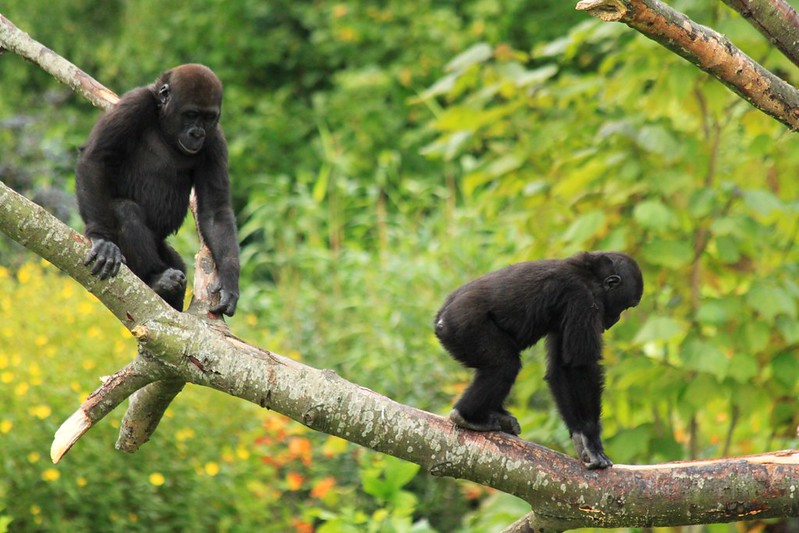Eastern Lowland Gorillas, facts, habits,Wight And size
The Eastern lowland gorilla is a severely endangered subspecies of the Eastern gorilla. Eastern lowland gorillas are indigenous to the mountainous forests of the eastern Democratic Republic of the Congo, primarily found in Kahuzi Biega National Park and other locations designated for eastern lowland gorilla conservation in Congo. Eastern lowland gorillas reside in lowland rainforests and dense montane forests within a tropical environment. A 2016 study by Fauna and Fauna International indicated a decline in the population of eastern lowland gorillas from 17,000 in 1995 to merely 3,800 individuals in 2016. Eastern lowland gorillas are classified as highly endangered, necessitating substantial conservation measures to ensure their survival for future generations.
Eastern lowland gorillas rank among the largest of the four gorilla species. Eastern lowland gorillas possess robust physiques characterized by substantial hands and hefty craniums, along with elongated arms featuring thumbs that extend much beyond the other digits. Male eastern lowland gorillas often reach a weight of up to 163 kg and a height of 1.69 m, but female eastern lowland gorillas can weigh up to 81 kg and measure 1.8 m in height. Eastern lowland gorillas possess jet black coloration similar to that of mountain gorillas, although their hair is somewhat shorter on the head and body. Upon reaching sexual maturity, typically at the age of 12 years, older male eastern lowland gorillas develop a patch of silver hair that covers their hindquarters. Female eastern lowland gorillas and immature male gorillas possess fur that is darker and significantly shorter than that of mountain gorillas. Immature male eastern lowland gorillas are referred to as blackbacks.

Female eastern lowland gorillas typically commence parturition after reaching maturity, generally at the age of 8 years or older. Female eastern lowland gorillas experience a gestation period of approximately 8.5 months, with mothers providing direct care for the infants. Infants remain in proximity to their moms for as long as five years until they achieve independence.
Eastern lowland gorillas, akin to other gorilla species, inhabit groupings known as troops. Gorilla families may consist of 5 to 30 individuals, led by a single dominant male. The leader of the gorilla group is typically the dominant silverback, who attains this position through age and strength, as they engage in combat to assert their authority. This often involves confrontations with other blackbacks who believe they possess the strength to lead, or even with rival silverbacks. Silverbacks oversee all aspects of the gorilla group, determining their feeding locations, nesting sites, and other group-related matters. Silverbacks also safeguard their family from threats and danger, even at the cost of their own lives. Eastern lowland gorillas, akin to other gorilla species, consume leaves and can ingest up to 18 kg of vegetation day. The food of eastern lowland gorillas mostly comprises shoots, roots, and leaves, supplemented by minimal quantities of tiny invertebrates such as ants and termites.
Eastern Lowlands: Threats to Eastern Lowland Gorillas
Threats to eastern lowland gorillas encompass poaching for bushmeat, civil unrest in the Congo resulting in gorillas being caught in crossfire, and habitat destruction due to human encroachment for agriculture, settlement, logging, and mining activities. Diseases pose a significant threat to the eastern lowland gorillas.
Where to see Eastern Lowland Gorillas in Africa
Eastern lowland gorillas are native to the Democratic Republic of Congo. Eastern lowland gorillas reside in Kahuzi Biega National Park, Maiko National Park, Tayna Gorilla Reserve, Usala Forest, and Itombwe Massif in the Congo. Travelers can see eastern lowland gorillas in Kahuzi-Biega National Park, Congo, on a lowland gorilla trekking safari. Trekking for eastern lowland gorillas involves people wandering through the forested areas of Kahuzi Biega National Park in pursuit of these primates.
Trekking for eastern lowland gorillas in Kahuzi Biega National Park is less strenuous than trekking for mountain gorillas in Virunga National Park, as the eastern lowland gorillas inhabit areas closer to the forest slopes. Trekking for Eastern lowland gorillas in Kahuzi Biega National Park may last from 30 minutes to over 2 hours, with guests permitted to spend only one hour in the presence of the gorillas. Gorilla trekking permits for encountering the eastern lowland gorillas are available at the Kahuzi Biega National Park headquarters, priced at $400 per person per trek.
Eastern lowland gorillas at Kahuzi Biega National Park can be observed year-round, however the dry season is the optimal period for gorilla trekking safaris in the park. Travel to Congo at any time for extraordinary interactions with the critically endangered eastern lowland gorillas. Travelers can encounter two taxa of gorillas exclusively in the Democratic Republic of the Congo: eastern lowland gorillas in Kahuzi Biega National Park and mountain gorillas in Virunga National Park. Consult an expert and educated tour operator to organize an exceptional Congo gorilla safari to observe the eastern lowland gorillas and other attractions.
